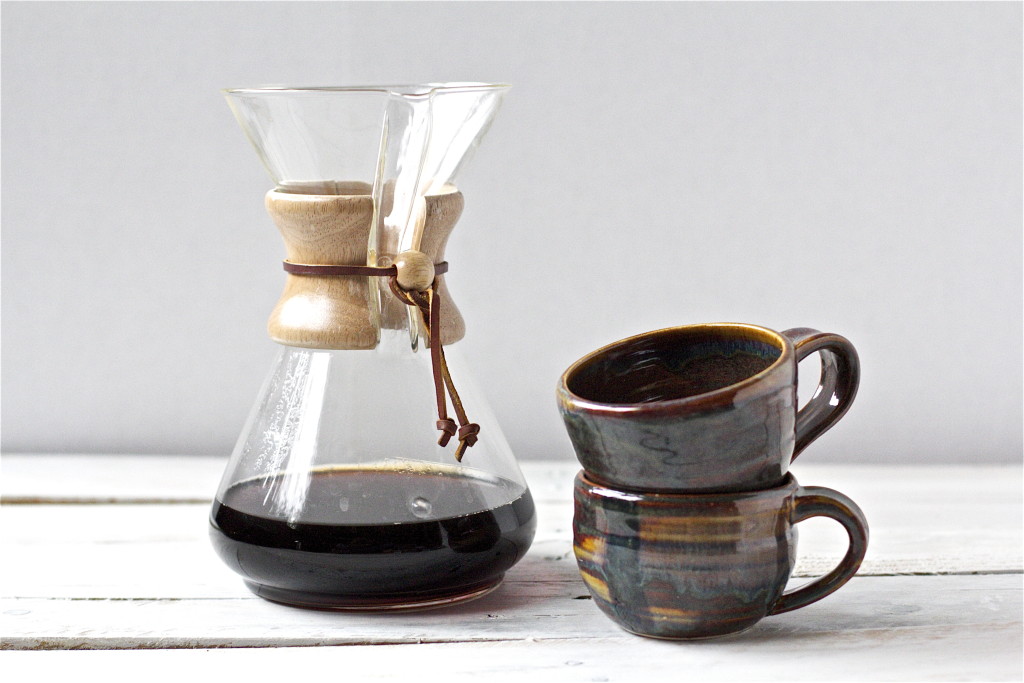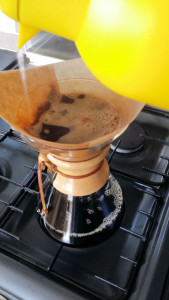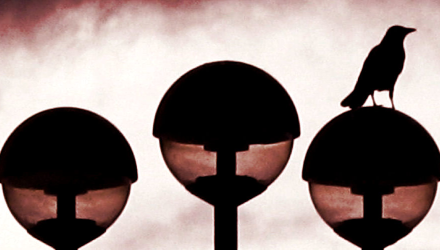It’s a common generalisation that writers are fuelled by coffee. (I know of one or two who reserve the coffee for the editing part, but it remains part of their process.) I consider myself one of the unfortunates who was born with a less than optimal quantity of caffeine naturally present in the bloodstream, thus being obliged to consume more merely in order to obtain some semblance of normal function. I drink a lot of it, and therefore am particular about it. My beans are fresh ground at home in a burr mill grinder approaching its fourteenth birthday, and every three weeks I buy freshly roasted beans, storing opened packets in an Airscape vacuum canister.
I believe I’ve tried just about every form of coffee making known to man with the exception of, thus far, cold brewed and the vacuum system used by Hannibal (the latter firmly out of my price range). I have a single cup drip filter, an Aeropress and a French press at work, choice dependent on how much time I have to make the coffee. At home I have a drip machine, stove top espresso maker (Moka pot), turkish coffee pot (Ibrik) and a Chemex.

The Chemex is a thing of beauty, and appeals to me because SCIENCE. I have used my fair share of conical flasks in my time. It also makes the best long coffee, in my opinion. If you like your coffee short, dark, bitter, thick and with crema, this isn’t for you; I generally prefer long to short, however.
It also has literary history: it’s the coffee maker used by James Bond, as specified in From Russia With Love:
It consisted of very strong coffee, from De Bry in New Oxford Street, brewed in an American Chemex, of which he drank two large cups, black and without sugar.
If that were not enough, it’s the only coffee maker to find a place in the Museum of Modern Art.
If you hadn’t guessed already, I’m a bit of a fan.
HOWEVER. It’s not a fast method (hence the machine drip filter for weekday mornings), and nor is it straightforward. Especially if, like me, you are a caffeine monster for whom the standard instructions for a brew to the button (the glass bubble near the bottom) are risibly inadequate.
This, fellow coffee lovers, is a method for brewing a LOT* of coffee in a 10 cup Chemex and keeping it hot while you undertake the business of the day without having it cooking on the stove.
Here’s what you need:
Left to right that’s an electric kettle (American readers, I have no idea what you use for boiling water, but use that instead), my trusty Dualit grinder containing 60g of freshly roasted Brazilian Yellow Bourbon, the Airscape from whence came the beans, a l litre vacuum flask and my 10 cup Chemex (CM-10A) containing a pre-folded unbleached filter. (I also use the bleached round unfolded filters, because, again, SCIENCE, but I think the unbleached gives a marginally faster flow so it’s possible to use a slightly finer grind of coffee and thus a slightly more complex flavour profile.) If you are making coffee just for yourself, you may want a larger flask, say 1.5l.
1. Boil about 500ml of water in your kettle. When it boils, put it in the empty flask. Now refill the kettle (ours has a capacity of 1.7l) but don’t switch it on, yet.
2. Grind your beans. It should be a moderately coarse grind, so the coffee ends up the texture of beach sand. While it’s grinding, using about half the water in the flask, rinse down the filter paper. It’s tempting to skip this step, but don’t. It gets rid of any residue from the packing and warms the Chemex. Discard the rinsing water.
3. Put the ground coffee into the Chemex. Switch on the kettle. Using just enough of the hot water still in the flask, soak the coffee until it’s saturated but not floating, then stir. Empty any remaining water from the flask but put the lid back on to retain heat.
4. Once the kettle has boiled, fill the flask. Use the water from the flask to pour over the coffee in the Chemex, using a spiral motion to ensure even coverage. Fill to within about 5mm of the glass rim. Stir again.
5. Top up the water in the flask using the water in the kettle. Transfer the Chemex to the stove top. If you have gas or ceramic you’re fine — if you have a coil element you will need a special heat diffuser to ensure you don’t damage the Chemex. Turn on the stove to its lowest setting.
6. Once the water has filtered through, top up the Chemex using the remaining water in the kettle (it will now have cooled to the ideal 90 – 92ºC) by pouring gently down the sides of the filter paper, washing the coffee grounds back down into the mix.
 7. Continue topping up the Chemex in this fashion using water from the flask, being careful not to overfill, until you have achieved the desired amount of coffee. In my case, this is to the neck.
7. Continue topping up the Chemex in this fashion using water from the flask, being careful not to overfill, until you have achieved the desired amount of coffee. In my case, this is to the neck.
8. Remove the filter paper, holding it above the Chemex for a few moments to allow any remaining coffee to drain. You don’t want to lose any.
9. Empty any remaining water from the flask (there won’t be much) and fill the flask with coffee. You can now pour yourself a mug using what’s left in the Chemex, safe in the knowledge the rest will stay hot for however long your flask is supposed to keep things hot.
10. Enjoy with your current reading material, or use to fuel words.




